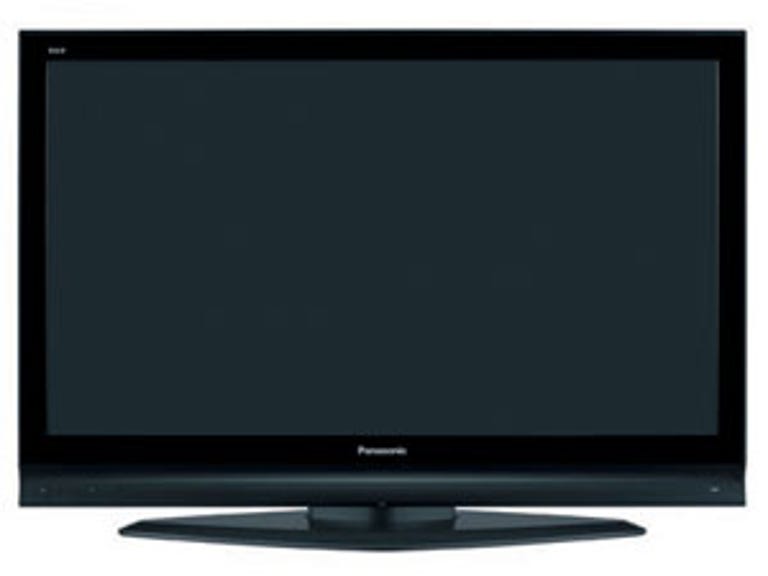 Why You Can Trust CNET
Why You Can Trust CNET Panasonic Viera TH-50PX70 review: Panasonic Viera TH-50PX70
Panasonic's TH-50PX70 is an impeccably designed 50-inch plasma, with equally impressive build quality and a gorgeous picture. If you're looking for a high-quality flat-screen TV at an affordable price, look no further
One of the first available models in Panasonic's 2007 Viera TV range, this 50-inch plasma screen comes in just below the flagship TH-50PZ700 model and can be found online for under £1,400.
The Good
The Bad
The Bottom Line
While it lacks the PZ700's 'Full HD' 1,920x1,080-pixel resolution, the TX70 is HD Ready and can be paired up with a Blu-ray player, HD DVD deck, HDTV service or next-generation games console. It also comes with a built-in digital terrestrial tuner for Freeview standard-definition TV.
Design
This is a 50-inch plasma TV, so unsurprisingly it's pretty large -- but not overly so. The frame surrounding the screen is narrow, with the speakers sneakily incorporated into it, so Panasonic has succeeded in trimming off much of the extra flab you see on many large flat-screen TVs. Weight-wise, it's fine -- not something you'd want to have to lug from room to room every day, but well-suited to wall-mounting.

The PX70's looks gorgeous, and even the pedestal stand feels solidly built
Like previous Viera plasmas, the build quality is top class. Everything feels completely solid, including the pedestal stand, and there's no sign of plasticky cheapness anywhere on the outside. It's a good-looking screen, too -- you can't really go wrong with black.
There are no inputs on the front or side panel, which might annoy anyone who likes to regularly hook a camcorder up to his or her telly to watch recordings. Everything is instead located around the back, where you'll find a couple of HDMIs, two RGB-capable Scarts and component video and VGA inputs, plus the accompanying audio sockets.
Features
The PX70 is fairly light on features, except for the basics you'd expect to see on any decent plasma TV.
For starters, there's very little in the way of picture tweaking options -- just the ability to adjust colour, contrast, brightness and sharpness, and a colour management and basic noise-reduction function. Most plasma and LCD HDTVs include individual colour temperature settings, several noise reduction modes and more, but you don't get that here (whether most users actually need all that stuff is debatable, mind you).
The menu system you use to adjust the settings is well designed, with large, crisp text and a simple layout. The remote control could be a little more responsive -- we often had to press buttons a few times to get a reaction -- but overall it works well.
The digital and analogue tuners are brilliantly easy to set up, as you can autotune both simultaneously. Again, things are quite basic with the digital Freeview tuner -- the electronic programme guide gives only a week's worth of information -- but it all works slickly enough. A common interface slot on the back means you'll be able to expand the digital service in the future, if necessary.
Performance
The digital tuner provides a good-quality picture for a plasma TV. Watching BBC Breakfast, for instance, you notice that it lacks crispness around the edges of objects, but at the same time colour gradations are smooth, and distracting digital noise is kept at an acceptable level.
Hooking up a Sky HD box, the results are much better. While the PX70's 1,366x768-pixel resolution means you can't take full advantage of Sky HD's 1080i resolution (the TV downscales the picture slightly), there's bags of detail in shows like Lost and movies like Walk The Line. We don't think the HD picture is as crisp as you'd see on a 1,920x1,080 resolution LCD like the Sony KDL-46X2000, though: it's a little softer and there's slightly less detail.
On the other hand, the black levels of this TV are excellent, meaning that you get a convincing, more cinematic contrast range than most LCDs. Black areas of the picture -- the smoke 'monster' in Lost, for example, or the deeper shadows in the background of a scene -- actually look black rather than dark grey. Colour reproduction is also a strong point, especially with HD material, with smooth, gradual light-to-dark transitions rather than ugly 'contours' of colour.
The blur-free motion also suits games perfectly -- even the fastest titles like the adrenaline-charged Motorstorm on PS3.
One issue with the screen is its slightly shiny surface, which reflects a fair bit of ambient light in a reasonably well-lit room. This can make darker images slightly indistinct if you're watching during the day -- unless you shut the curtains.
The built-in speakers perform ably if not outstandingly, with a good balance between power and clarity.
Conclusion
While we'd have preferred this TV to have a 1,920x1,080 'Full HD' resolution so that it could display a little more detail with HD sources, it's certainly one of the most impressive plasma TVs around. Much like the Pioneer PDP-5000EX, it creates a smooth image with convincing colour reproduction and excellent blacks -- and all for about £4,000 less.
It's also impeccably designed, with outstanding build quality, a good set of connections and styling that'll fit in nicely with most living rooms. If you're looking for a high-quality flat-screen TV at an affordable price, look no further.
Edited by Jason Jenkins
Additional editing by Kate Macefield
